PinotFile: 10.43 November 30, 2016
|
Let’s Toast California Pinot NoirThe holidays offer the opportunity for toasts at dinners and parties, so why not use one of these occasions to toast California Pinot Noir? I have had a 50-year love affair with Pinot Noir. I drank California Pinot Noir long before it ever became fashionable and was fortunate to live through the renaissance of North American Pinot Noir. I had my trysts with the great Chalone Reserve Pinot Noirs of the 1980s, the venerable Pinot Noirs of Mt. Eden, Calera and Hanzell, the early Central Coast Pinot Noirs of Sanford and Lane Tanner, and the world class early Russian River Valley Pinot Noirs of Gary Farrell, Rochioli, Dehlinger and Williams Selyem. Many of these wines were revelations, even epiphanic, and love at first sip. I was fortunate that my wine drinking lifetime coincided with the dramatic achievements in excellence of California Pinot Noir, but the joyride is not over. Currently, there is an embarrassment of riches and the overall quality of California Pinot Noir has reach extraordinary levels. The bar has moved to such lofty heights that a disproportionately large number of premium Pinot Noirs now receive scores of 90 or above. I have to shake my head in amazement at the skilled hands of today’s winegrowers and winemakers who continue to strive for perfection in Pinot Noir. I have never given a California Pinot Noir a score of perfection (100), and although perfection will probably never be achieved, an increasing number of wines come damn close. As Yogi Berra would say, “If Pinot Noir were perfect, it wouldn’t be.” It’s time to toast our blessings! Toasting is thought to originate in ancient Greece and Rome according to many sources. Since poisonings were popular and sanitation not reliable, hosts knew that guests would be uneasy about the wines or other libations offered, so the host often took the first drink. When it was clear that the host was going to survive, he would raise his cup and invite his guests to drink in good health. Historians believe the word “toast” originated in ancient Rome when burnt toast was added to libations to counteract the high acidity. After reciting “a toast,” the bread was removed from the wine and consumed. The term “toast” evolved by the late seventeenth century to refer to the practice of celebrating one’s fellow drinkers, friends and family. The custom of clinking glasses along with a toast is thought to have originated with the early Christians, who performed the ritual believing that the noise would banish the devil. It has become customary in this country to clink the glass of every person at the table, a custom first practiced by the Germans. Here are a few toasts you can use as you celebrate the ascendency of California Pinot Noir this holiday season. When I looked through multiple books and my own collection of quotes, I found no toasts specifically directed to Pinot Noir so I took the liberty to modify a few quotes (my apologies to the originators).
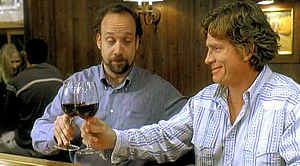 He who has wealth and Pinot Noir will always have friends The human heart rejoices in good Pinot Noir May your love be like great Pinot Noir, and grow stronger as it grows older You can have too much Pinot Noir to drink, but you can never have enough Life consists not in holding good Pinot Noir, but in drinking those you hold There is white wine, red wine and then there is Pinot Noir Champagne makes you think of silly things: Bordeaux makes you talk about them; Pinot Noir makes you do them There are many ways to the recognition of truth, and Pinot Noir is one of them
In the pages to follow, look carefully, and you will find many extraordinary examples of California Pinot Noir and Chardonnay. Since I have so many wines to review before year’s end, I have not included elaborate commentary on every winery. Please see the Winery Directory in the PinotFile website for detailed information on wineries and wine availability.
Etude Sources Far and Wide for Marvelous Pinot NoirI last wrote about Etude in the PinotFile in 2013: www.princeofpinot.com/article/1363/. Etude is a pioneering winery in the Napa Carneros region of California started by noted winemaker Tony Soter in 1980. The winery was initially an underfunded proprietary side project focusing on Carneros Pinot Noir, Napa Valley Pinot Blanc, Napa Valley Merlot, Carneros Pinot Gris, Vin Gris of Pinot Noir and Brut Rosé sparkling wine. At the time, Soter was a busy winemaking consultant for high profile wineries including Araujo Estate, Shafer, Spottswood and Viader. Soter owned no vineyards, but bought grapes by the acre with vineyard blocks farmed to his own specifications, a unique proposition at the time. The name Etude is derived from the French word “étude,” meaning “study.” Soter chose this name because he felt Pinot Noir was the most transparent wine vehicle with which to “study” the craft and pursue the wisdom of ancestors he never had. Soter’s wines attracted considerable praise from the wine press and by 1999, he was able to concentrate full time on Etude and develop estate vineyards. Etude was sold to Fosters Wine Estates in 2001, and Soter returned to his native Oregon to establish a second Pinot Noir project at Mineral Springs Ranch after making his last wines at Etude in 2002. Soter has continued as a consulting winemaker at Etude. The new corporate owners infused new cash into the winery, building a new winemaking facility, refurbishing estate vineyards, and expanding production.
 Jon Priest joined Etude as winemaker in 2005. Until that time, Pinot Noir was primarily sourced from Carneros sites that drew its character from clay-heavy soils that created more extracted and tannic wines. More recently the centerpiece of Etude Pinot Noir has been the Grace Benoist Ranch Estate Vineyard located in the northwestern corner of the Carneros appellation in the Sonoma Carneros region, a site featuring rocky, well-drained, volcanic soil. Jon is a California native who established a reputation for crafting memorable estate red wines while working at Wild Horse Winery and Adelaida Cellars for more than twelve years, and at TAZ Vineyards in the Central Coast. Beyond his winemaking expertise, Jon (pictured below) is also an acclaimed equestrian who competes in racing events over legendary trails once crossed by earlier pioneers.
 The wines reviewed here represent a unique tasting that examines six distinct expressions of Pinot Noir from six different growing regions as part of the winery’s Appellation Series. I found all the wines to be distinctive and reflective of unique terroirs, but the wines from California were especially glorious examples of domestic Pinot Noir, all of them exhibiting superior craftsmanship. These were simply some of the best, if not the best, California Pinot Noirs I have tasted from the 2014 vintage. The wines can be enjoyed now but will age beautifully because of their impeccable balance. The Etude Pinot Noirs undergo cold maceration and small lot open-top fermentation with extended time on the skins, and are then aged for 10-13 months in French oak barrels (25%-33% new). The wines undergo a rigorous selection process to insure only the best barrels are chosen for the final blend. Etude Wines welcomes visitors from 10:00 a.m. to 4:30 p.m. at 1250 Cuttings Wharf Road in Napa, just off Highway 121. Several special tasting options are available by reservation and are described on the website at www.etudewines.com (reservations can be booked online). Most of the wines reviewed here are currently available on the website. Along with the 2014 vintage wines reviewed here, Etude offers a Carneros Pinot Noir ($45), a Heirloom Grace Benoist Ranch Pinot Noir ($95), a Temblor Carneros Pinot Noir ($75), a Carneros Deer Camp Pinot Noir ($75), and a Forte Sta. Rita Hills Pinot Noir ($60) from the 2014 vintage.
2014 Etude Grace Benoist Ranch Estate Grown Carneros Pinot Noir 14.3% alc., $45. This is a blend of the best grapes from individual parcels on the Ranch located in southern Sonoma in the northwestern corner of the Carneros AVA. 13 different soil types, all variations of volcanic origin. Dijon 667, 777, 113, 114, 459, Pommard, Martini and various heirloom selections. · Moderate reddish purple color in the glass. Intoxicating aromas of black raspberry, spice, and earthy potpourri. A terrific wine that instantly perks up your attention with ingratiating mid weight flavors of black raspberry, blackberry, spice, white pepper and mushroom with a deft touch of oak seasoning. Sensual on the palate, with sinewy tannins and enough power to seduce. Still terrific the following day from a previously opened and recorked bottle indicating long-term age ability. Quintessential Carneros and one of the best Pinots I have tasted from this region in my recent memory. Score: 96
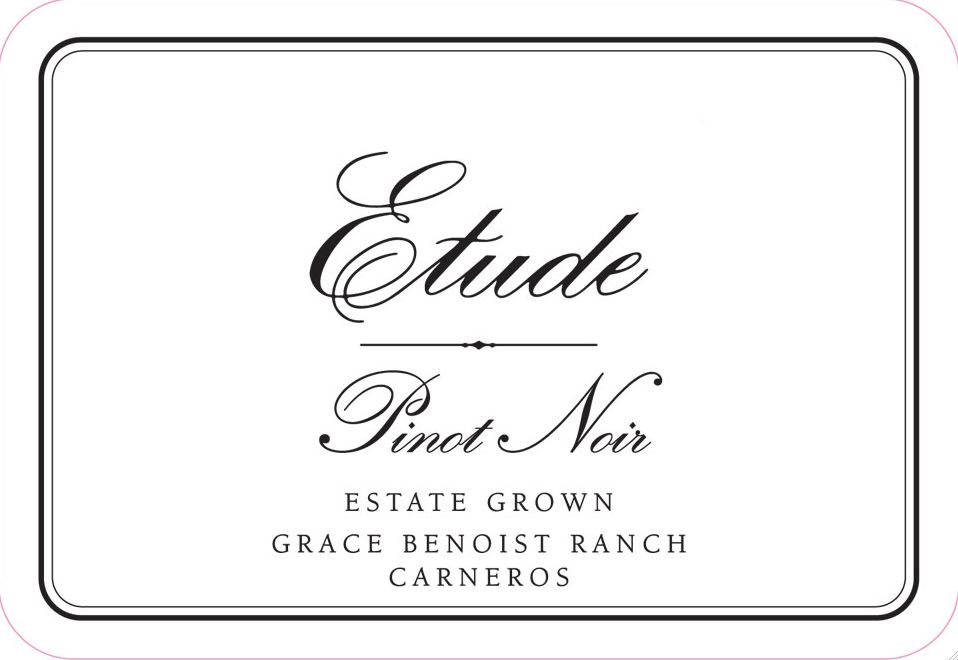
2014 Etude Ellenbach Vineyard Sonoma Coast Pinot Noir 14.8% alc., $60. Vineyard is 4 miles from Pacific Ocean in Annapolis in the northernmost West Sonoma Coast. It is positioned just above the fog line at 800 feet elevation on a steep hillside. A variety of clones are planted in Goldridge soil, unique among the region’s volcanic soils. Dijon “828,” and 115. · Moderate reddish purple color in the glass. A mysterious nose that releases its charms slowly over time in the glass, climaxing with a gorgeous array of dark purple fruit, cardamom spice and sous-bois aromas that overwhelm. A delicious core of dark fruits is perfectly accented with spice and a schmear of oak. This wine has a polished demeanor, with refined tannins and a very impressive and high-spirited finish that is both juicy and persistent. You need this beauty in your cellar. Score: 95
2014 Etude North Canyon Vineyard Santa Maria Valley Pinot Noir 14.4% alc., $45. This vineyard sits along the Santa Maria River bench in a secluded canyon. A variety of clones and rootstocks are planted in calcareous clay sandstone, differing from the valley’s defining marine mixture of ancient sea bed, clay loam and sand. This wine is made from a select block located on a bluff in the southern, cooler end of the canyon. Dijon 115, 667, 777 and 113. · Moderately light reddish purple color in the glass. Love the nose that brings an array of aromas including dark fruits, brier, baking spices, tobacco and turned earth. Beautifully composed and easy going, with very tasty purple and black fruits and an earthen underbelly. The tannins are well integrated and there is recognizable length on the pleasing finish. Primarily a fruit-driven wine, but so harmonious that it will grab your attention. Score: 93
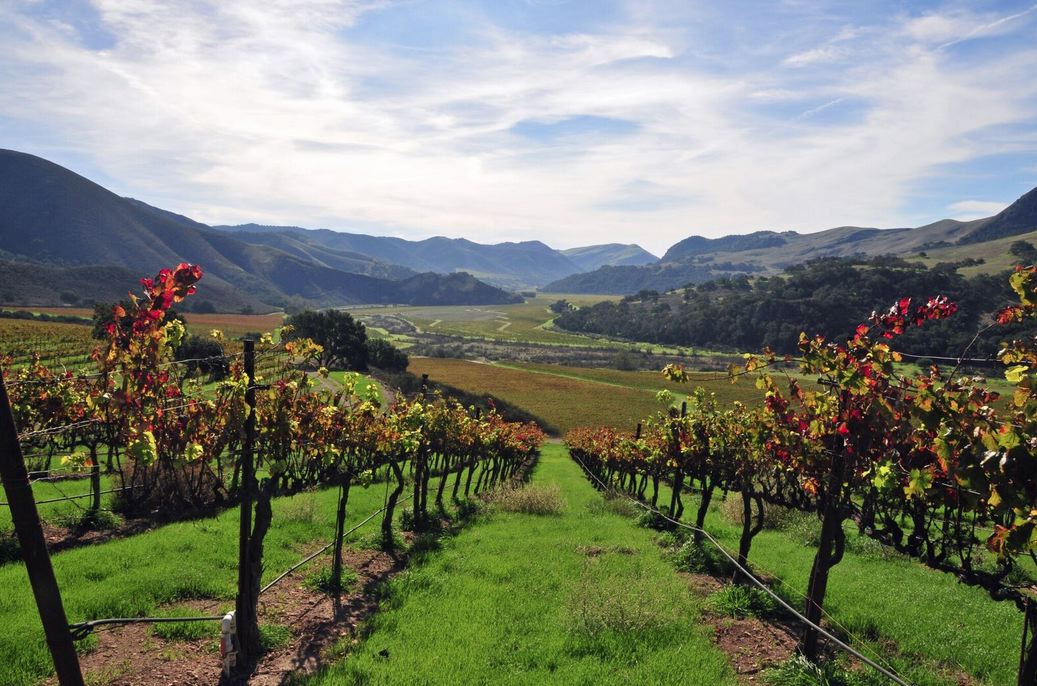
2014 Etude Fiddlestix Vineyard Sta. Rita Hills Pinot Noir $45. Vineyard is located about 10 miles inland from the Pacific Ocean alongside the Santa Ynez River bench at the western end of the Santa Ynez Valley. 35 small blocks with a variety of rootstocks and clones planted in well-draining clay loam and calcareous marine shale.Clones 667, 777, 113, Pommard 4 and 5. · Light cherry red color in the glass. Engaging perfume of fresh crushed cherries, savory spices and rose petal. Very silky and elegant, with sportive mid weight flavors of ripe strawberry and black cherry fruits with a welcome touch of spice. The tannins are noticeably refined, something of note since the tannins can be aggressive in wines from this vineyard. Just a touch of oak seasoning is complimentary. A brilliant offering, with a finish that goes on and on. The winemaker’s extensive experience with the fruit from this vineyard shows in the excellence of this wine. A superb value to boot. Score: 94
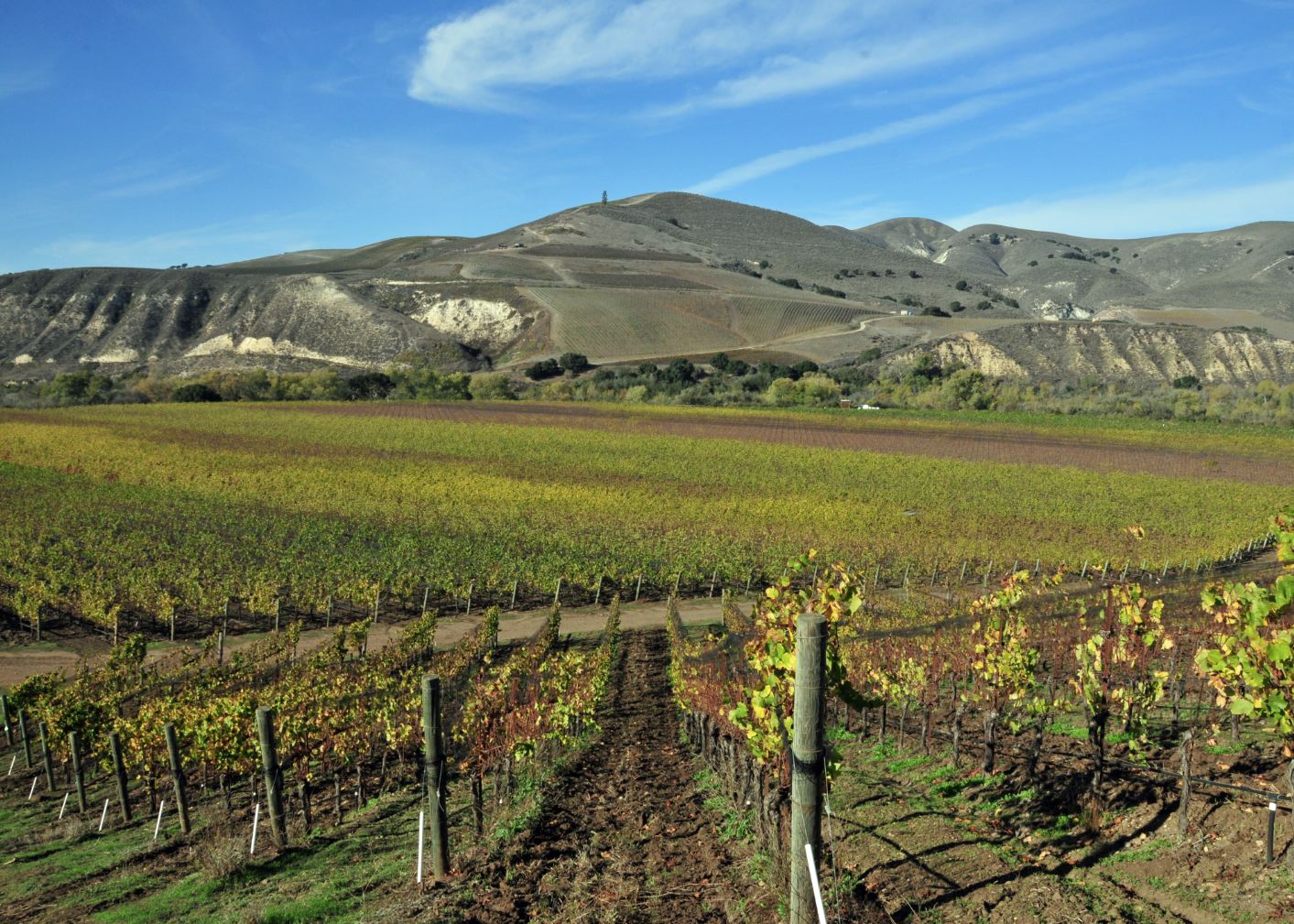
2014 Etude Yamhill Vista Vineyard Yamhill-Carlton Willamette Valley Oregon Pinot Noir 14.3% alc., $60. Vineyard is located at 600 feet elevation and is planted in sedimentary soil. Dijon 113 and Pommard clones. · Moderately light reddish purple color in the glass. Shy but pleasant aromas of black cherry pie and rose petal. Not as concentrated as many 2014 vintage Oregon Pinot Noirs, but this wine still has plenty of ripe fruit to satisfy, including flavors of black cherry and marionberry, along with an interesting iron and earthy undertone typical of sedimentary Willakenzie soils. Juicy and harmonious, with impressive grip and hold on the rocking finish. Score: 92
2014 Etude Bannockburn Central Otago New Zealand Pinot Noir 13.8% alc., $60. Bannockburn is slightly warmer and drier than the rest of the region. The climate is continental with low rainfall, low humidity and daily extremes of temperatures. The soils are schist gravel with varying amounts of silty loam, clay and sand. Dijon 777 and 117. Winemaker Jon Priest collaborated with colleagues in Central Otago on this wine and it was then sent to Etude Wines. · Moderate reddish purple color in the glass. This wine is a departure in style from the other Pinot Noirs in the 2014 Etude lineup. The nose offers aromas of very ripe dark fruits, prune and molasses. Full-bodied, with a plethora of dark purple and black fruit encased in soothing, cashmere tannins. Somewhat simple and fruit-driven, with an herbal thread in the background and a good cut of acidity on the finish. Score: 89
Recently Tasted California Pinot Noir
CIRQ. Estate, SebastopolCommentary: Powerhouse “Rock and roll” wines crafted in winemaker Michael Browne’s style that is often imitated, but rarely duplicated.
2013 CIRQ. Treehouse Russian River Valley Pinot Noir 14.5% alc., pH 3.53, TA 0.575, 1,748 cases, $125. Clones 23, 37, Calera, CC, Pommard and Swan. · Moderately dark reddish purple color in the glass. Earthkissed aromas of purple grape and boysenberry jam. Powerfully fruited with expressive and sappy purple and black fruits embellished by a touch of oak. Cashmere tannins make for a suave, velvety mouthfeel. A sensual, loquacious wine that has an impressively long and generously fruited finish. Score: 92
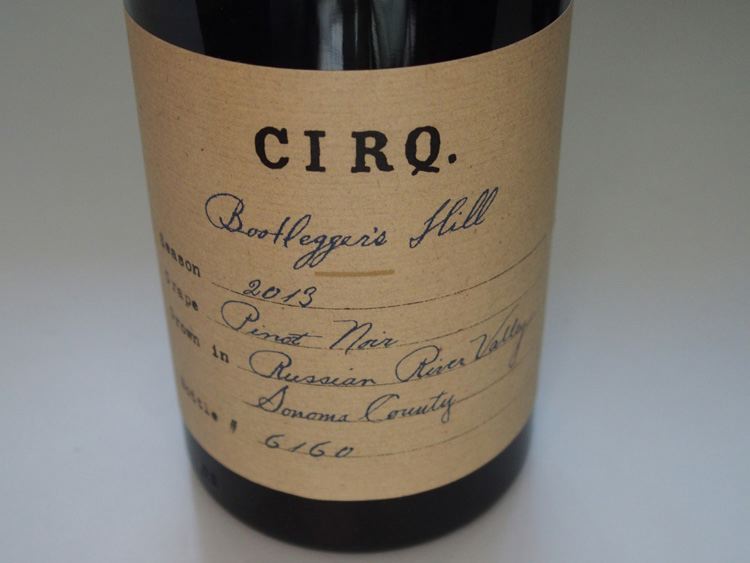 2013 CIRQ. Bootlegger’s Hill Russian River Valley Pinot Noir 14.5% alc., pH 3.60, TA 0.58, 694 cases, $125. Clones 23, 37, Calera, CC, Elite and Pommard. · Moderate reddish purple color in the glass. Soaring aromas of fresh dark red and black stone and berry fruits with a sexy spice component. A glamorous wine that offers impeccable balance between sweet, sappy purple fruits and firm structural integrity. The mouthfeel is seductive, the acidity gives energy and lift to the prodigious fruit, and the extraordinary finish defies description. Still wonderful two days later from a previously opened and re-corked bottle. A masculine wine with a sensual side. Score: 95
Domaine De La Côte, LompocThis winery has established quite a reputation since its first release with the 2011 vintage, with leading international critics proclaiming it as one of the most exciting new wine projects to emerge from California. Proprietors and winemakers Rajat Parr and Sashi Moorman have planted in one of the coldest microclimates on the Western Coast of the United States.Beyond the wines reviewed here, 2014 saw the inaugural release of Siren’s Call Pinot Noir ($120), the highest elevation vineyard of the estate planted at 7,000 vines per acre and 100% own-rooted, and Juliet Chardonnay. The wines are highly allocated. Commentary: If you like your Pinot Noirs elegantly composed, and very fresh, vibrant and juicy tasting with modest alcohols, you will find these wines highly appealing. These Pinot Noirs display the style that personified the In Pursuit of Balance (IPOB) movement, and I found them distinctly stylistic in a very good way. (These wines were not submitted to me for review) The bottle presentation is particularly appealing.
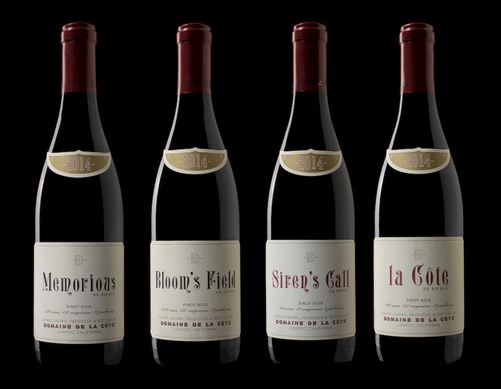
2014 Domaine De La Côte Memorious Sta. Rita Hills Pinot Noir 13.0% alc., 470 cases, $60. · Light reddish purple color in the glass. The nose gives up its charms slowly over time in the glass, offering lively aromas of dark red cherry, spice and rose petal. Modest in weight, and rather delicate in demeanor, but packing a punch with juicy flavors of black cherry, black raspberry and exotic spice. The dry tannins are well proportioned, and the cut of citrus-driven acidity lifts the wine to a high-spirited finish. Score: 92
2014 Domaine De La Côte Bloom’s Field Sta. Rita Hills Pinot Noir 12.5% alc., 1,020 cases, $70. · Moderately light reddish purple color in the glass. Exotically perfumed, with aromas of black cherry, pine sap, rose petal and spice reflective of whole cluster inclusion. Light to mid weight in style featuring redder fruits including cherry, raspberry and cranberry. A slight leafy, herbal thread, presumably from whole cluster inclusion, adds a savory note. Elegantly composed, with a fresh, juicy personality and a bright, upbeat finish that lingers. Score: 93
2014 Domaine De La Côte La Côte Sta. Rita Hills Pinot Noir 12.5% alc., 820 cases, $90. 100% whole cluster. · Moderately light reddish purple color in the glass. A searching nose that mesmerizes the drinker with aromas of cherry, cola, pipe smoke and smoky caramel that picks up noticeable intensity over time in the glass. This wine has a little more of everything, including fruit sap, oak and tannin, but they all blend seamlessly in this mid weight plus offering featuring dark red fruits. There is a charming briskness and freshness to this wine that encourages the drinker to linger over every sip and refreshes for the next taste. The finish is of Grand Crus length as well. This is the stuff that Pinot dreams are made of. Dreamers can expect this wine to age beautifully for ten years or more. Score: 98
Domaine Della, Santa Rosa
2014 Domaine Della Keefer Ranch Russian River Valley Pinot Noir 14.5% alc., pH 3.55, TA 0.57, 250 cases, $70. Aged 15 months in French oak barrels, 45% new. · Moderate reddish purple color in the glass. Aromas of very ripe, slightly confected cherries, spice, raisin and maple lead off. Luxurious core of black cherry and blackberry fruits push the ripeness envelope, crossing over to a prune note. Well-composed, with silky tannins, and an oak-driven caramel and brown sugar accent. The Keefer Ranch seemed to give riper fruit in the 2014 vintage. Score: 89
2014 Domaine Della Terra de Promissio Sonoma Coast Pinot Noir 14.5% alc., pH 3.52, TA 0.59, 175 cases, $70. Aged 15 months in French oak barrels, 47% new. · Moderate reddish purple color in the glass. I was seduced by the aromas of black raspberry and blackberry jam with a compliment of toasty oak and spice. A mid weight plus styled wine with a juicy core of black raspberry and black cherry fruit that arrives in waves on the palate. Sleek and balanced, with a satiny mouthfeel, gossamer tannins, restrained oak persuasion, and a fruit-filled finish. This wine offers the pleasure of both finesse and power. Score: 92
Dutton-Goldfield Winery, SebastopolDutton-Goldfield Winery began in a vineyard in 1993, when longtime colleagues and friends Steve Dutton and Dan Goldfield recognized a shared vision between them. The wines reviewed here are generally vinified as follows. After de-stemming into small open top fermenters, the grapes undergo a 7-day cold soak. After fermentation, the wine is racked into French oak barrels, then racked and blended once in the spring of the following year to choose favorite barrels, homogenize the blend, and hone in on barrel choices for final aging until bottling. The wines are aged 10-15 months in 50%-55% new barrels. Commentary: This lineup of wines from exotic sites will please Pinot Noir connoisseurs. The fruit flavors are fresh and luscious, the textures are seamless, the oak is well integrated, and the wines finish with noticeable generosity. The only nit I have is that the wines all have a similar flavor profile and lack individuality at this early stage of their evolution. This can be the case when the wines all feature Dijon clones. The differences among the single-vineyard terroirs is subtle and may be challenging to detect except for exceptionally experienced palates. Drinking window: 1-8+ years.
2014 Dutton-Goldfield Devil’s Gulch Vineyard Marin County Pinot Noir 13.5% alc., pH 3.54, TA 0.61, 560 cases, $68. A steep, terraced vineyard located in far western Marin County owned and farmed by noted vineyardist Mark Pasternak. Dijon clones. · Moderately light reddish purple color in the glass. The aromas of blackberry essence, spice cabinet, earth and mulch draw you into the glass. Impressive fruit purity is on display in this middleweight offering with flavors of blackberry, black raspberry and boysenberry underlain with oakdriven notes of smoke and tobacco. Juicy acidity, soft tannins and a sustained finish make for a very pleasurable drinking experience. Score: 92
2014 Dutton-Goldfield Azaya Ranch Vineyard Marin County Pinot Noir 13.8% alc., pH 3.53, TA 0.61, 375 cases, $58. Vineyard is located in cold and foggy valley in western Marin County. Vineyardist Mark Pasternak planted the 18-acre Azaya Ranch for the McEvoy family on a south and west facing hill in Hicks Valley. Clones are 667, “828,” 115, 777 and Wädenswil 2A. This wine contains 667, “828,” and 115 clones. · Moderate reddish purple color in the glass. Initially elusive, the aromas of dark red and purple berries, spice cabinet and even roseate arrive over time in the glass. Attention-grabbing attack, expansion and finish, with a mid weight essence of boysenberry and black raspberry fruits kissed by a variety of spices. The most tannin in the 2014 lineup, this wine exhibits a slight astringency on the finish at present. Still, this wine is fresh and giving, and ready to go now. Score: 92
2014 Dutton-Goldfield Angel Camp Vineyard Anderson Valley Pinot Noir 14.1% alc., pH 3.55, TA 0.57, 313 cases, $58. Farmed by Brian Zalaznick, this vineyard is located on the western side of Philo on a slope above the Navarro River. 11.5 acres of Dijon and heritage clones planted in gravelly soil. This wine is composed of Pommard, “828,” and 667 clones. · Moderate reddish purple color in the glass. The perfume of blackberry jam, black tea, roseate scent, and herb seasoning is quite satisfying. Mid weight flavors of blackberry, baking spices and coffee are nicely balanced with the t n’ a. Satiny in the mouth, with an array of dark fruits fanning out on the finish. Score: 90
13.5% alc., pH 3.67, TA 0.60, 646 cases, $62. This vineyard, first planted in 2001, is situated on a ridge outside the small town of Graton. Vines are planted in Goldridge soil. Clones for this wine are Pommard, Wädenswil 2A, 667 and “828.” · Moderate reddish purple color in the glass. Welcoming aromas of blackberry reduction, sous-bois and vanilla. Crisp and lively in the mouth, with a mid weight core of boysenberry and blackberry fruit framed by perky acidity and modest tannins. A gracious wine, with oak vanillin in the background and a pleasing finish showing off fresh blackberry essence. Score: 91
2014 Dutton Goldfield Fox Den Vineyard Green Valley of Russian River Valley Pinot Noir 13.8% alc., pH 3.41, TA 0.67, 565 cases, $62. This vineyard is located at the western border of Green Valley just above the town of Occidental. Soils are Goldridge sand loam. Dan Goldfield and Steve Dutton planted this 8-acre vineyard in 2002 on the home site of Ed and Sue Smith. Dijon clones 667, 777 and 115. · Moderate reddish purple color in the glass. The nose offers a plethora of savory scents including earthy flora and herb seasonings as well as raspberry and mocha notes. Very fresh and lively in a mid weight style featuring flavors of strawberry and red and black raspberry. Highly engaging and generous, slightly creamy in texture, modest in tannins, and finishing with a crispness that appeals. This wine has all the features that we have come to relish in Pinot Noir: perfume, texture, elegance and freshness. Score: 94
2014 Dutton-Goldfield Dutton Ranch Freestone Hill Vineyard Russian River Valley Pinot Noir 13.9% alc., pH 3.60, TA 0.64, 657 cases, $72. This vineyard, planted in 1996 and 1997, is located a few miles inland from Bodega Bay on a south-facing hillside above the town of Freestone. This very cold site produces tight bunches and tiny, thick-skinned berries. Clones are 115, Wädenswil 2A and 114 co-fermented, and 667. · Moderate reddish purple color in the glass. Dark berry fruited on the nose with a mid weight plus nucleus of lush dark stone and berry fruits lifted by good acidity and framed by discrete tannins. Satiny in the mouth, with enviable balance, good richness without being jammy, and noticeable intensity on the finish. Score: 92
2014 Dutton-Goldfield McDougall Ranch Vineyard Fort Ross-Seaview Sonoma Coast Pinot Noir 13.9% alc., pH 3.58, TA 0.63, 475 cases, $62. Farmed by Mac, Rich and Barbara McDougall, this vineyard is situated on a high elevation (1,100 feet), south-facing ridge. 9 acres of Dijon clone Pinot Noir first planted in 1998 upon the urgings of Warren Dutton. Neighbors are Hirsch vineyards and Martinelli vineyards. · Moderate reddish purple color in the glass. The nose reminds me of blackberry jam on a warm croissant. Comforting in the mouth, with a mid weight core of glorious black cherry, black raspberry and blackberry fruit framed by slinky tannins. Very charming, with a juicy freshness that is uplifting. Score: 93
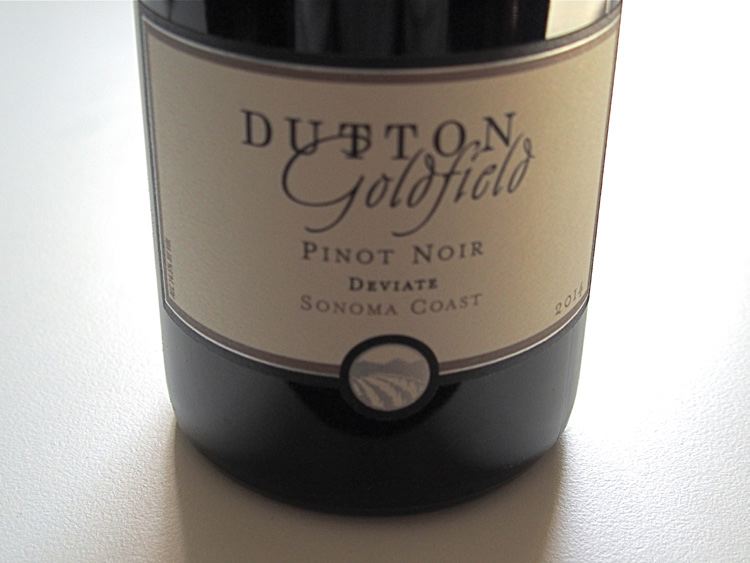 2014 Dutton-Goldfield Deviate Sonoma Coast Pinot Noir 14.4% alc., pH 3.55, TA 0.63, 325 cases, $72. The 8th small Pinot Noir bottling (DV8). A deviation from the winery’s single vineyard focus, this wine is a blend from two favorite vineyards, Jentoft Vineyard in Green Valley (Calera selection planted in 2003) and Ellenbach Vineyard near Annapolis. · Moderately dark reddish purple color in the glass. Aromas of damp earth, pine and mashed blackberries soar from the glass. Rich and luxurious, with a charge of well-spiced boysenberry and blackberry fruits that saturate the palate and adroitly fade slowly through an enduring finish. Quite sappy, yet possessing a nimble demeanor. Firm, but supportive tannins supply a backbone for aging in this marvelous wine. Score: 95
Halcón Vineyards, San Francisco
2014 Halcón Wentzel Vineyard Anderson Valley Pinot Noir 13.1% alc., pH 3.39, TA 0.53, 160 cases, $35. This organically farmed vineyard is located at 500-feet elevation on a steep, northwestern-facing hillside exposed to the cool, foggy influence of the Pacific Ocean. A blend of Dijon clones. 35% whole cluster, native fermentation, no acid or alcohol adjustment, and aged in French oak barrels including a single new Francois Frères oak puncheon (20% new oak total). Bottled unfined and unfiltered. · Moderately light reddish purple color in the glass. Low aromatic interest, with very shy scents of blackberry and spice. Light, earth-kissed flavors of cherry, blueberry and blackberry. Simple, and easy to drink, with modest tannins and some finishing power. A nice wine, but not extraordinary. Score: 88
2014 Halcón Oppenlander Vineyard Mendocino County Pinot Noir 13.3% alc., pH 3.54, TA 0.52, 160 cases, $32. Vineyard is located 10 miles east of the coastal town of Mendocino and is one of the coolest vineyards in California. Dry farming and low vigor soils lead to small berries and clusters. 66% Pommard clone and 33% Dijon 115 clone. Native fermentations, no adjustments for acid or alcohol. 30% whole cluster. Aged in French oak barrels, 25% new. Bottled unfined and unfiltered. · Moderately dark reddish purple color in the glass. The nose reminds me of a walk in a dark cave, with damp earth notes and black cherry in the background. The mid weight black cherry and blackberry fruit flavors have noticeable mid palate presence. Slightly rugged, with firm, gritty tannins and a slightly astringent finish. Score: 88
Keller Estate, Petaluma100% estate wines for over 25 years from vineyards in the Petaluma Gap region of the Sonoma Coast. The added bottle age of these wines has greatly benefited their drink ability.
2013 Keller Estate La Cruz Vineyard Sonoma Coast Pinot Noir 13.9% alc., pH 3.63, TA 0.57, 817 cases, $45. Primarily Pommard clone. Tight vine spacing and low yields from the estate vineyard exposed to the strong winds and fog of the Petaluma Gap. · Moderately light reddish purple color in the glass. Well-composed aromatic highlights including cherry, raspberry coulis, and brioche. Mid weight flavors of black cherry, black raspberry, spice and a hint of complimentary oak in the background. Forward drinking and easy to like, with good balance and a stately elegance. Score: 90
2013 Keller Estate El Coro Sonoma Coast Pinot Noir 14.2% alc., pH 3.62, TA 0.587, 396 cases, $52. The El Coro Vineyard is high on a ridge top. The name translates to “The Choir” in Spanish. The site is windy with extreme growing conditions and planted to extensive clonal variation. 6 clones including “828,” 667, 115 and a La Tache selection that creates the backbone of this wine. Aged in French oak barrels, 27% new. · Moderately light reddish purple color in the glass. Very seductive aromas of dark cherry, exotic spices including cardamom and refined oak. Silky and elegant, with a mid weight thrust of engaging black cherry, blackberry and spice flavors with a subtle earthy tone and a touch of umami. Good tannic bones and a lasting, powerful finish complete the experience. Score: 93
2013 Keller Estate Precioso Sonoma Coast Pinot Noir 14.2% alc., pH 3.63, TA 0.57, 70 cases $75. A special barrel selection from the 2014 vintage. 100% de-stemmed, aged in French oak barrels, 35% new. · Moderately light reddish purple color in the glass. A sophisticated offering with seeking aromas of dark cherry, blueberry, mushroom, underbrush and oak spice. A delicious array of darker fruits greats the palate with aplomb, expanding in the mouth and lasting like what seems 30 seconds on the finish. Perfect harmony, a deft touch of oak spice, and an earthy, savory bent that adds interest. Texturally very interesting, featuring dry, suede tannins that predict age ability. A regal offering that will please any Pinot connoisseur. Score: 94
Kessler-Haak Vineyard & Wines, Santa BarbaraEstate grown Pinot Noir, Chardonnay and sparkling wines from Dan and Ellen Kessler. The estate vineyard in the Sta. Rita Hills was planted in 2005 and the winery’s first vintage was 2008. Pinot Noir is typically destemmed, cold soaked for 4 days, racked into French and Hungarian oak barrels for malolactic fermentation and aging, and the wines are bottled unfined and unfiltered. Bottled wines are typically aged up to 1 year before release. The wines are sold on the website at www.kesslerhaak.com. Commentary: These are well-crafted wines that are sensual on the palate and deliver generous dark fruit flavors. The tannins are nicely corralled as well. A shortcoming is that several of the wines have too little of the characteristic Pinot perfume. There is also a tobacco note in the background of some of the wines yet new oak use is very modest. Overall, the wines are well-priced for the quality. Drinking window: now-5+ years.
2013 Kessler-Haak Ohana Sta. Rita Hills Pinot Noir 14.2% alc., 650 cases, $40. Clones 113, 114, 115, 667, 777, and Wädenswil 2A. Aged in French oak barrels, 17% new. · Moderately dark reddish purple color in the glass. Initially, the nose is primarily savory with aromas of earthy flora, brier and barrel, with shy cherry fruit showing up over time in the glass. Discreetly concentrated, juicy and silky, with a mid weight core of black cherry and dark berry fruits accented with notes of anise, tea leaf and dark chocolate. Good balance, with a modest finish. Score: 89
2013 Kessler-Haak Synergy Sta. Rita Hills Pinot Noir 14.4% alc., 400 cases, $42. Composition is 55% Pommard, 25% 777 and 20% 667. Aged in French oak barrels, 10% new. · Moderate reddish purple color in the glass. Aromas of blackberry and tobacco oak lead to a middleweight styled wine with plenty of black cherry and black raspberry fruit flavors to satisfy. Seamless and silky, even seductive in the mouth with some finishing generosity. A solid wine, but I wanted more Pinot perfume and a less tobacco highlights. Score: 89
2013 Kessler-Haak Sanctuary Sta. Rita Hills Pinot Noir 14.2% alc., 150 cases, $42. 50% clone 113 and 50% clone 114. Aged in French oak barrels, 10% new. · Moderately dark reddish purple color in the glass. Pleasant scents of cherry pie, bakery and toast. Rich and bold in a mid weight plus style, filled with luscious black cherry fruit that saturates the mid palate, yet silky and polished and easy to like. Fruit-driven and plush, and hard to resist. Score: 90
2013 Kessler-Haak Intuition Sta. Rita Hills Pinot Noir 13.21% alc., 50 cases, $42. 100% Wädenswil 2A. Aged in French oak barrels, 0% new. · Moderately dark reddish purple color in the glass. The nose is primary, with little to report other than aromas of potpourri. More giving on the palate, with a robust core of well-ripened black raspberry and blackberry fruits underlain with a green note, finishing with juicy, slightly tart acidity. This clone is known for providing aromatic lift, but it is absent in this wine. Score: 87
2013 Kessler-Haak Four Sta. Rita Hills Pinot Noir 14.7% alc., 50 cases, $42. 100% Pommard. Aged in French oak barrels, 50% new. · Moderate reddish purple color in the glass. Soaring aromas of cherry, spice, bark and rose petal. Modest in weight, but highly flavorful, with a well-spiced core of fresh cherry fruit framed by supportive oak. The cherry fruit is perfectly ripened with appropriate phenolic expression. Highlights include silky tannins, immersed alcohol, and a hedonistic finish that really holds on. For me, Pommard clearly produces the most engaging single clone wine among all the Pinot Noir clones. Score: 92
2013 Kessler-Haak Symphony Sta. Rita Hills Pinot Noir 14.04% alc., 75 cases, $42. 50% clone 115 and 50% clone 777. Aged in French oak barrels, 33% new. · Moderately dark reddish purple color in the glass. The nose is primary, offering little to describe. The big boy of the lineup, with generous bass in this symphony. Fullboded flavors of black fruits and mocha with oak seasoning in the background. Satiny in the mouth, with firm but slippery tannins, finishing with a bold charge of fruit. Cellaring would be advised to allow time for the nose to arrive. Score: 90
Kosta Browne, Sebastopol
2014 Kosta Browne Keefer Ranch Russian River Valley Pinot Noir 14.6% alc., pH 3.50, TA 0.62, $90. An Estate vineyard (Kosta Browne bought 20 acres of Keefer Ranch in 2013, but Marcy Keefer continues at the helm of Keefer Ranch) located in the southwestern corner of the Russian River Valley planted in Goldridge soils. Clones are 115, Wädenswil 2A, 777, “828,” Pommard, Swan, Calera, 114 and 23. Grapes are destemmed, fermented in 5-ton stainless steel and wood open top tanks after a 5-day cold soak. Aged 16 months in French oak barrels, 40% new. · Moderate reddish purple color in the glass. Nicely perfumed, with enticing aromas of black cherry, blackberry jam and oak spice. A mouthful of well-spiced and fully ripened dark stone and berry fruits engage the palate and fan out on the finish. The oak is beautifully married, the texture is silky, and the fruit-driven finish has good length and satisfying intensity. Score: 91
2014 Kosta Browne Gap’s Crown Vineyard Sonoma Coast Pinot Noir 14.5% alc., pH 3.55, TA 0.585, $90. Kosta Browne has worked with this property since 2006 and now have a long-term lease of 37 acres. Clones 114, 115, 667, “828,” and Swan. 100% de-stemmed, 5-day cold soak, fermented in 5-ton open-tops, 1-ton wood open tops, and 16% fermented and aged in concrete. 84% aged 16 months in French oak barrels, 25% new. · Moderately dark reddish purple color in the glass. Aromas of black cherry, blackberry and toasty oak arrive slowly over time in the glass. The mid weight core of unbridled forest-toned dark fruits satisfy as does the slippery mouthfeel. Sturdy on the palate with an oak-driven mocha thread. Impressive balance, with uncommon persistence on the powerful finish. Score: 92
La Pitchoune Winery, Santa RosaInspired by a small family property in the south of France, La Pitchoune means “The little one.” The name speaks to small production, small lots and the idea that small size is a great asset.
2014 la pitchoune VDK Sonoma Mountain Pinot Noir 14.1% alc., pH 3.73, TA 0.54, 48 cases, $58. Sourced from Van der Kamp Vineyard. Dijon 777 and “828,” and a La Tache selection. Harvest Brix 22.0º-24.8º. Aged 24 months in French oak barrels, 50% new and 50% once used. · Moderately light reddish purple color in the glass. You will want to go on sniffing this wine that offers very pleasing aromas of cherry and earthy flora. Beautifully composed, with a succulent core of cherry fruit enhanced with notes of cola, spice and earth. Fresh and juicy, with pedigreed fruit flavors, an age worthy tannic backbone, impeccable oak integration, and a satisfying finish. Score: 93
2014 la pitchoune English Hill Vineyard Sonoma Coast Pinot Noir 13.1% alc., pH 3.63, TA 0.58, 98 cases, 98 cases, $58. Dijon 115, 667 and a Vosné-Romanee selection. Harvest Brix 23.2º-23.7º. Aged 11 months in French oak barrels, 25% new, 25% once used and 50% 4 years or older. · Moderately light reddish purple color in the glass. A relentless nose that pumps out aromas of dark red cherry, sassafras, and sandalwood over time in the glass. Juicy mid weight flavors of black cherry and black raspberry play in harmony with tannins and acidity, and persist on the finish that is immensely satisfying. My only nit is that oak chimes in a bit too much. Score: 90
Mignanelli Winery, Sonoma
2014 Mignanelli Highlands Ranch Santa Lucia Highlands Pinot Noir 14.2% alc., $32. An 18- acre vineyard planted in 2001. Native fermentation, 40% whole cluster with hand and feet punchdowns. Clones are 115, 667, 777 and Pommard. Aged in French oak barrels on the lees, 20% new. Bottled unfined and unfiltered. · Moderately dark reddish purple color in the glass. The nose evolves over time nicely, offering scents of briery black cherry, game, rose petal and vanilla. Modest in weight, with flavors of black raspberry, black plum, blackberry and tobacco. The whole cluster contributes more to the nose than palate, but does not generate unwieldy tannins. The wine picks up approachability and finishing intensity over time in the glass. Score: 90
2014 Mignanelli KW Vineyard Santa Lucia Highlands Pinot Noir 13.9% alc., $32 (sold out). A 6-acre vineyard planted in 2000 by Kirk William located between Rosella’s and Garys’ vineyards but lower in elevation. Soils are decomposed granite with quartz. Native fermentation, 60% whole cluster, hand and feet punchdowns. Clones are Pommard and 667. Aged in neutral French oak barrels. Bottled unfined and unfiltered. · Dark reddish purple color in the glass. Aromas of black cherry, cola, spice, sweet pipe smoke and even a hint of diaper. Full-bodied, with a delectable sweet black cherry core accented with notes of spice and stem. The fine-grain tannins are modest and the wine tempts with a pleasing finish. The added whole cluster adds more nuance and interest in this wine. A manly, daring wine that remains very agreeable. Score: 92
Portalupi Wines, HealdsburgCommentary: Would I buy these wines? No. Are they bad wines? Absolutely not. Do I find scoring these wines challenging? Yes. Winemaker Tim Borges has a stylistic goal that does not align with my personal preference, but the long standing success of the wines would indicate they have a dedicated consumer fan base. The three wines reviewed here are stylistically consistent.
2013 Portalupi Russell Family Vineyard Paso Robles Pinot Noir 15.5% alc., 240 cases, $60. Vineyard is located on the western side of Highway 101 and is planted in shallow, rocky calcareous soil. The site experiences large temperature variations from highs of 90 degrees to lows of 40 degrees. Harvest Brix 27º. Pommard and Dijon clones. Aged 12 months in Francois Frère French oak barrels, 25% new, 75% 1-year-old medium plus toast. · Moderately dark reddish purple color in the glass. Aromas of nutty oak and earthy flora obscure any fruit on the nose. Lush, plush and fruit-driven, this is an opulent wine featuring black raspberry and blackberry flavors veering to raisin. This wine is reflective of this warm site and I have always found wines from this vineyard to be very tannic like this wine is and more like Zinfandel in character. That said, this wine does honestly reflect the terroir, and seems to stay relatively balanced. Score: 89
2014 Portalupi Sonoma Coast Pinot Noir 15.2% alc., 327 cases, $30. Harvest Brix 25.0º. Clones are Martini 13 and 15, and Wädenswil 2A. Aged 14 months in French oak barrels, 20% new, 60% 1- year-old and 20% 2-year-old, medium plus toast. · Moderate reddish purple color in the glass. The very ripe black fruit aromas are slightly stewed and are accompanied by scents of forest floor and oak bark. Full-bodied, with husky tannins, in a fruit-driven style featuring a rich core of well ripened black cherry fruit accented with a savory mushroom note. The alcohol is balanced by the hedonistic core of fruit and tannins and the wine shows no trace of alcoholic heat on the finish. Score: 89
2014 Portalupi Dolinsek Ranch Russian River Valley Pinot Noir 15.0% alc., 118 cases, $40. Dijon clones. Harvest Brix 25.0º. Aged 14 months in French oak barrels, 40% new, 40% 1-year-old, and 20% 2-year-old. · Moderately dark reddish purple color in the glass. Aromas of dark berry mash, spice, seasoned oak and prune lead off. Very ripe and sappy, even slightly roasted dark fruits are featured backed by modest tannins. There is a welcome hint of oak spice seasoning, the mouthfeel is silky, and the wine displays admirable balance. If you don’t mind fruit pushed to maximum ripeness, you will like this nicely crafted wine that is stylistically unique. Score: 89
Roger Roessler Wines, SonomaRoger Roessler Wines has multiple brands including Black Pinot Pinot, R2 Wine Company and Roger Roessler Signature Series that are reviewed here. Commentary: The wines reviewed here all are aromatically pleasing with an appealing elegant style.
2013 Roessler Wine Cellars Guidici Vineyard Sonoma Coast Pinot Noir 14.3% alc., pH 3.73, TA 0.536, 68 cases, $68. Vineyard is located 4 miles south of Occidental amidst coastal redwoods in the extreme southwestern end of the Sonoma Coast. Native yeast fermentation, aged 14 months in French oak barrels, 50% new. · Light cherry red color in the glass. Inviting aromas of cherry, spice and sous-bois that persist over time in the glass. Elegantly style and satiny in texture, with light to mid weight flavors of cherry, Damsel plum and blueberry with an add earthy flora accent. Peach skin tannins, admirable balance, skillful touch of oak, and a modest but enduring finish. Score: 92
2013 Roessler Wine Cellars Day Ranch Anderson Valley Pinot Noir 14.2% alc., pH 3.77, TA 0.536, 647 cases, $38. Vineyard is located in one of the cooler parts of the Anderson Valley and is a 30-year-old, dryfarmed site. Entirely composed of a heritage Beaujolais clone of Pinot Noir, a true rarity. Native yeast fermentation, aged 14 months in French oak barrels, 20% new. · Light reddish purple color in the glass. Aromas of earthy cherry, rose petal, mushroom and sandalwood lead off. Elegant in demeanor, with a light to mid weight core of cherry and blueberry fruits accompanied by a thread of herbs. The tannins are noticeable yet genteel, the wine offers good harmony, and finishes with a high cherry note. Score: 90
2014 Roessler Wine Cellars Bogey Vineyard Sonoma Coast Pinot Noir 14.3% alc., pH 3.65, TA 0.555, 150 cases, $42. Vineyard is located at 1000 feet elevation overlooking the town of Sonoma and is exposed to cooling winds from San Pablo Bay. Co-fermented clones 115 and 777 using organic French yeasts. Aged 15 months in French oak barrels, 16% new. · Moderate reddish purple color in the glass. Aromas of black cherry, peppery spice and wine cellar lead to a mid weight styled wine that is cherry driven with added accents of cola, spice, coffee, and savory herbs. Mild tannins, with a modest, but juicy finish. Score: 89
2014 Roessler Wine Cellars Hein Vineyard Anderson Valley Pinot Noir 14.1% alc., pH 3.80, TA 0.49, 94 cases, $54. Vineyard is in the far northwestern end of Anderson Valley in proximity to cool Pacific breezes. Native yeast fermentation, aged 11 months on lees in French oak barrels, 25% new. · Moderately light reddish purple color in the glass. A remarkably nuanced wine with aromas of black cherry, blackberry, grilled beef, spice, sous-bois and mulch leading to enticing mid weight plus flavors of black raspberry, blackberry, spice and mushroom. A relatively bold yet honorable wine with silken tannins and some noticeable aromatic persistence on the finish. Score: 92
2014 Roessler Wine Cellars Lennox Vineyard Russian River Valley Pinot Noir 14.2% alc., pH 3.55, TA 0.61, 135 cases, $54. Vineyard is located in the cool southwestern edge of the Russian River Valley and planted in Goldridge soils. Composed of Dijon clones 667, 777 and 115 all fermented separately. Organic yeast fermentation, aged 14 months in French oak barrels, 40% new. · Moderate reddish purple color in the glass. The perfume of blackberry, blackest cherry, potpourri and oak vanillin draws interest, while the mid weight plus core of purple and black berry sweet fruits provide a hedonistic charge of pleasure. The most concentrated wine in the lineup, with healthy supporting tannins and a thread of oak in the background, finishing with some length and intensity. My nit would be this wine does not show the signature characteristics of Russian River Valley Pinot Noir. Score: 89
Windy Oaks Estate Winery & Vineyards, CorralitosThe estate is located in a temperate location at 1,000 feet elevation on a ridge overlooking the Monterey Bay. 18 acres are planted to Pinot Noir and Chardonnay and are hand tended. The small winery was built to complement the small lot production approach. French oak barrels made with 3-year air-dried wood are used exclusively. The winery believes in long barrel aging and the typical Windy Oaks Pinot Noir is aged for 18-25 months and bottled unfined and unfiltered. The Chardonnay is barrel fermented and aged for over a year. Proprietors Jim and Judy Schultze are the driving force, with Jim as the winemaker. They have over 20 years of interest and experience in artisanal winemaking, first developed when they lived in Europe and Australia, and supplemented by the UC Davis vineyard and winemaking programs. Each year they visit their Burgundian barrel makers in France and meet with selected vignerons to exchange information and winemaking techniques. The two wines reviewed here have just been released and will be available to wine club members and at the winery’s tasting rooms.
 2013 Windy Oaks Estate Les Deux Grands Cru Special Release Santa Cruz Mountains Pinot Noir 13.7% alc., pH 3.39, TA 0.69, 24 cases, $105. Estate grown, produced and bottled. This single barrel was so outstanding that it was deserving of its own special release. Partial native fermentation, 30% whole cluster, aged in a single new French oak barrel for 25 months. Bottled unfined and unfiltered. Moderately light reddish purple color in the glass. · Aromas of fresh berries plucked from the vine, cherry, spice and a touch of barnyard. Tremendous attack of black cherry fruit with accents of rhubarb and baking spices, and a hint of nutty, toasty oak. The texture is dreamy and the finish goes on and on. Even better the next day from a previously opened and re-corked bottle, with round shoulders, soaring aromas, and flavors of spiced cherries wrapped up in an elegant package. Score: 96
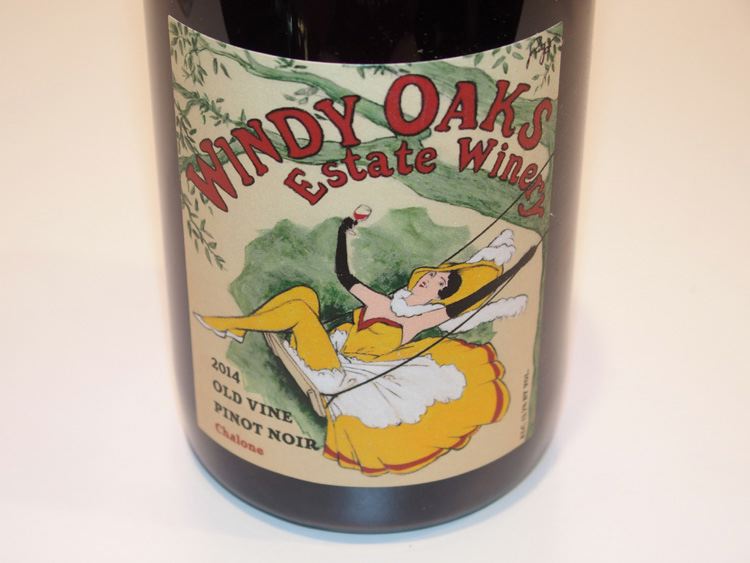 2014 Windy Oaks Old Vine Chalone Mt. Harlan Pinot Noir 13.7% alc., pH 3.45, TA 0.68, 48 cases, $65. These sourced old vine grapes were crushed, fermented, aged and bottled at Windy Oaks Estate. Dick Graff took over Chalone Vineyard in the Gavilan Mountains in the mid 1960s. The vines had been originally planted by a Frenchman in 1919. Graff nursed the vines back to health and planted new vines. This bottling is the result of a small allocation from Graff’s early plantings. Partial native fermentation, 50% whole cluster, aged 21 months in French oak barrels, 50% new. Bottled unfined and unfiltered. · Light cherry red color in the glass. Complex aromatic gifts including black cherry, sous-bois, briar, spice and nutty oak, reaching more heights with time in the glass. A connoisseur’s wine that is not propelled by rich fruit but rather by nuance and complexity. Mid weight flavors of cherry, red berry and spice are surprisingly intense considering the light color of the wine. Elegantly crafted and perfectly balanced, with fine grain tannins, juicy acidity, and an astonishingly long, orgasmic finish. This wine brought back memories of my encounter with a 1990 DRC Romanée-Conti wine many years ago. Not a powerhouse, but like an angel that is heaven sent. Score: 97
More Wines
2014 Arthur Russian River Valley Pinot Noir 14.6% alc., pH 3.49, TA 0.77, 50 cases, $35. Winemaker Takahiro Momoi sources grapes from the Green Valley of Russian River Valley for this bottling. Aged for up to 14 months in seasoned French oak barrels. · Light cherry red color in the glass. Aromas of cherry, bark, and tobacco lead to a middleweight styled wine featuring flavors of oak-kissed black cherry, tobacco and cola. A welcoming satiny mouthfeel and more fruit lushness than one would expect from the modest color makes for good drinking. The cherry fruit has a slight confected tone and there is a bit too much oak overlay, but otherwise this is a commendable wine. The wine was better the following day when tasted from a previously opened and re-corked bottle with better oak immersion and more flamboyant cherry and spice flavor. Score: 89
2015 Copain “Tous Ensemble” Mendocino County Pinot Noir 13.5% alc., 6,500 cases, $28. An appellation blend from Abel, Nelson, Hein and Hennenberg vineyards. Aged 9 months in neutral French oak barrels. · Moderately light cherry red color in the glass. Pleasant aromas of cherry, pomegranate and cranberry are echoed in the light weighted flavors. Simple, but satisfying, with sleek tannins, a refreshing lift of acidity, and a modest finish. A solid, harmonious, everyday drinker. Score: 88
2014 LIOCO Saveria Vineyard Santa Cruz Mountains Pinot Noir 12.4% alc., pH 3.57, TA 0.58, RS 0.1 g/L, $55. Vineyard located near the town of Aptos, 4.5 miles from the Pacific Ocean. Clones 115, 667 and 777 planted in the late 1990s. Soils are well-drained sand and calcerous marine deposits. Farmed by noted vineyardist Prudy Foxx. Harvest Brix 21.5º. Clones co-fermented with wild yeasts. 20% whole cluster. · Moderately light reddish purple color in the glass. Complex nose offering aromas of cherry, exotic spices, leather saddle, stem, earthy salad greens and subtle oak. Light to mid weight flavors of cranberry, strawberry and red cherry are delicately composed and underlain with an herbal thread. Both savory and fruity in a gentle style finishing better than on the attack. Noticeable tannins show up on the finish. Score: 88
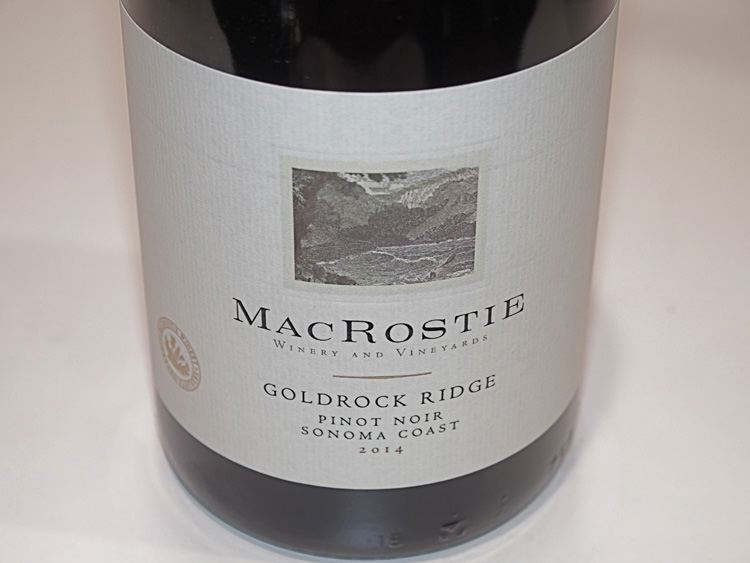 2014 MacRostie Goldrock Ridge Sonoma Coast Pinot Noir 14.8% alc., 441 cases, $56, screwcap. This vineyard is located in the remote reaches of northwestern Sonoma County, a few miles from the Pacific Ocean near Annapolis. At 780-feet elevation, the site is exposed to marine air that frequently brings fog. The result is delayed ripening of mature vines which are grown on low vigor, gravelly loam soil. Clones are 777 and “828.” 100% de-stemmed, inoculated yeast strains, 3-day cold soak, pump-overs and punchdowns. Barrel aged for 17 months in French oak, 40% new. · Moderate reddish purple color in the glass. Lovely aromas of fresh blackberry compote and spice. Exuberant mid weight plus flavors of black raspberry and boysenberry satisfy on the attack and mid palate. Highly flavorful, beautifully ripened fruit backed by crisp acidity and filigree tannins in an impeccably balanced wine that deserves high accolades, especially for the intensely fruited, ebullient finish. Score: 94
2014 Sea Smoke Southing Sea Smoke Estate Vineyard Sta. Rita Hills Pinot Noir 14.6% alc., pH 3.45, TA 0.63, $60. Cool microclimate, southern exposure, clay soils and low yields. Vineyard has been farmed organically and biodynamically since 2013. 1 to 4-day cold soak, inoculated cultured yeasts, total maceration time of 14 to 18 days. Aged 16 months in French oak barrels, 55% new. · Moderate reddish purple color in the glass. Dark berries and stone fruits with a hint of spice are featured on this very pleasant nose. A luscious, but not overbearing array of dark fruits have an earthy bent and are well supported by vital tannins. Soothing in the mouth, with a deft touch of oak seasoning, integrated acidity, and a lengthy, blackberry-driven finish. Still very young, and will benefit from more time in the cellar. Score: 92
2014 Talley Vineyards Rosemary’s Vineyard Arroyo Grande Valley Pinot Noir 14.1% alc., 625 cases, $70. Three generations of family farming in the coastal San Louis Obispo County. The wine is grown, produced and bottled by Talley Vineyards. SIP Certified Sustainable. · Moderately light reddish purple color in the glass. The nose sports deep aromas of dark red fruits and sous-bois. Modest in weight, with a focus on dark red cherry and raspberry fruit flavors with an earthen riff. Barrel treatment is gracious. The tannins are supportive, the mouthfeel is silky, and there is good length on the acid-fueled, lip-smacking finish. Score: 91
Recently Tasted ChardonnayA recent commentary by noted wine critic, Charles Olken, in Connoisseurs’ Guide to California Wine, November 18, 2016, caught my interest. He was writing about the demise of the In Pursuit of Balance (IPOB) movement and made several salient points about the good and bad of this organization. It was concerning Chardonnay that his message was so relevant: “It is in the making of Chardonnay that we see the greatest and most lasting influence of IPOB. Whether one likes, or used to like, the big, buttery side of Chardonnay (we do), we see changes for the better in that style and a willingness across the board to make brighter, more lively versions.” You will find examples in the reviews to follow.
Brighter, crisp versions of Chardonnay
2015 Copain Tous Ensemble Mendocino County Chardonnay 13.8% alc., 2,500 cases, $28. Now owned by Jackson Family Wines, but still crafted by Wells Guthrie. Tous Ensemble is French for “Put Together.” An appellation blend sourced from DuPratt, Ferrington and Hein vineyards. Aged in both neutral French oak barrels and stainless steel. · Light golden yellow color in the glass. Very clean aromas of lemon, pineapple, vanilla creme and a hint of caramelized oak. Crisp on the palate and finish and easy to like, with flavors of white peach, pear and coconut. Score: 89
2014 DION Vineyard Estate Limited Release Chehalem Mountains Oregon Chardonnay 12.8% alc., 94 cases, $25. Harvest Brix 21.1º, harvest pH 3.20. Clone 76 picked early to preserve acidity. A blend of French oak barrel (20% new) and stainless steel tank ferments. · Very light golden yellow color in the glass. Reduction on the nose (struck match) that persists over time. Crisp and bright on the palate, with very delicate flavors of green apple, lemon and pear, ending with a lean, soprano finish. Score: 85
2013 Keller Estate Oro De Plata Sonoma Coast Chardonnay 14.1% alc., pH 3.57, TA 0.63, 811 cases, $33. The name Oro De Plata translates to “Gold from Silver.” Backbone of this wine is Block 6 planted to Wente clone in 1998. Some Block 5 Wente 4 clone and another block planted to Robert Young clone add to the mix. Fermented in stainless steel and aged 8 months in neutral French oak barrels. No malolactic fermentation. · Light lemon yellow color in the glass. Reserved aromas of lemon, nori, tropical fruits and nutty oak. Smooth and slightly creamy on the palate in a button-up yet pleasing style with flavors of citrus and pear fruits. Refined and polished, with oak unplugged. A food magnet wine. Score: 92
2014 Talley Vineyards Rosemary’s Vineyard Arroyo Grande Chardonnay 14.1% alc., 425 cases, $45. SIP Certified Sustainable vineyard. · Light golden yellow color in the glass. Aromas of lemon zest, lemongrass, vanilla and blond caramel lead off. Somewhat lean and streamlined, with an array of citrus fruit flavors and very little oak seasoning. Sophisticated, with appealing restraint and refinement, offering bright acidity, and finishing with a delightful burst of citrus. Score: 92
2014 Windy Oaks Old Vine Estate Santa Cruz Mountains Chardonnay 13.8% alc., pH 3.41, TA 0.63, 71 cases, $55. Sourced from Miller Family Vineyard consisting of 1 acre planted in the early 1960s on a ridge 900 feet above Monterey Bay. Windy Oaks Estate manages the vineyard. Barrel fermented and aged 18 months with lees stirring through malolactic fermentation in once and twice-used French oak barrels. Bottled unfined and unfiltered. · Moderate golden yellow color in the glass. The nose is a bit atypical yet offers some traditional aromas of lemon, apple and straw. More enjoyable on the slightly creamy palate, with intricate flavors of lemon, pineapple, grapefruit, apple, burnt caramel and petrol, shepherded by brisk acidity. Score: 87
Big, more buttery, yet lively versions of Chardonnay
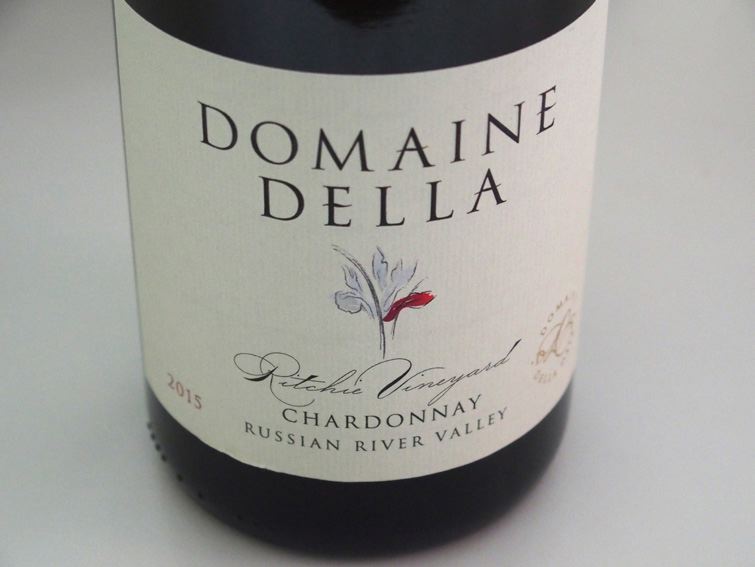 2015 Domaine Della Ritchie Vineyard Russian River Valley Chardonnay 14.5% alc., pH 3.20, TA0.66, 120 cases, $70. Aged 12 months in French oak barrels, 30% new. · Light golden yellow color with a slight haze in the glass (unfiltered). Engaging aromas of lemon, pineapple, white peach and brioche. The flavors echo the aromas with added tropical fruit, slate and salinity accents. Barrel treatment is unobtrusive, the wine has very enviable vibrancy, and finishes with excellent cut fueled by lemon-citrus goodness. A regal wine from a vineyard that is California Chardonnay royalty. Worth the investment in pleasure. Score: 94
2013 Keller Estate La Cruz Vineyard Sonoma Coast Chardonnay 14.1% alc., pH 3.59, TA 0.607, 818 cases, $38. The winery’s flagship Chardonnay. Barrel fermented with native yeasts and aged on the lees. 100% malolactic fermentation. Wente and Robert young clones. Aged 11 months in French oak barrels, 25% new. · Light lemon yellow color in the glass. A lot to discover in the nose, with aromas of tropical fruits and flowers, buttery brioche, lemon oil, coconut water and seashell. Fruit flavors of pineapple, guava, lemon are mixed with butterscotch and graham in this well-composed wine with integrated acidity and a clean, uplifting finish. Score: 91
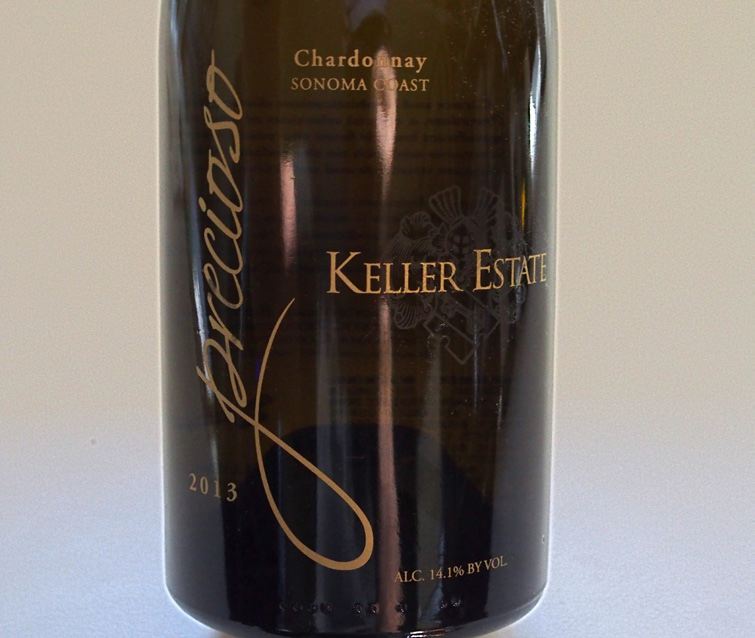 2013 Keller Estate Precioso Sonoma Coast Chardonnay 14.1% alc., pH 3.58, TA 0.607, 69 cases, $75. A barrel selection from the excellent growing season in the Petaluma Gap. 100% malolactic fermentation. Aged in French oak barrels, 35% new. · Light lemon yellow color in the glass. The nose reminds me of a day at the beach with aromas of sand and fresh salt air. There is also fruit notes of lemon and pineapple, and even a hint of plumeria. Impeccably crafted, fresh and clean like the ocean in Maui, with flavors of citrus, tropical pineapple, white peach and a hint of oak in the background. The genteel texture is a very captivating feature as well. Mahalo. Score: 95
2014 la pitchoune Sonoma Coast Chardonnay 14.2% alc., pH 3.47, TA 0.59, 225 cases, $48. Sourced from Pratt, Chenoweth and Dutton-Sullivan vineyards. Clones are selections of Wente, Wente-Hyde, Robert Young and Mt. Eden. Harvest Brix 23.4º-23,9º. Aged 16 months in French oak barrels, 10% new, 90% twice used or older. · Moderately light golden yellow color in the glass. Enticing aromas of lemon, pineapple, blond caramel, and caramelized banana. Vivacious on the palate, with flavors of lemon, pineapple and tropical fruits. Plenty of fruit to relish, yet energetic acidity brings an uplifting tone to this marvelous wine with impeccable balance. Very easy to like on its own or paired with richly sauced white fish dishes. Score: 94
2014 MacRostie Wildcat Mountain Vineyard Sonoma Coast Chardonnay 14.5% alc., 1,080 cases, $46, screwcap. Vineyard owned by Steve MacRostie and his partners Nancy and Tony Lilly. Clone 76, 95 and 17. Whole cluster pressed, cold settled, cool fermentation, aged 10 months in French oak barrels on the lees with stirring throughout the aging process. The best barrels from each lot were selected for the Wildcat Mountain blend. · Moderately light golden yellow color in the glass. A polished, refreshing wine with clean aromas of lemon, pineapple and brioche leading to flavors of lemon, vanilla and toasty, buttery oak. Easy to drink, with uplifting energy, generous fruit flavors and admirable balance. Score: 91
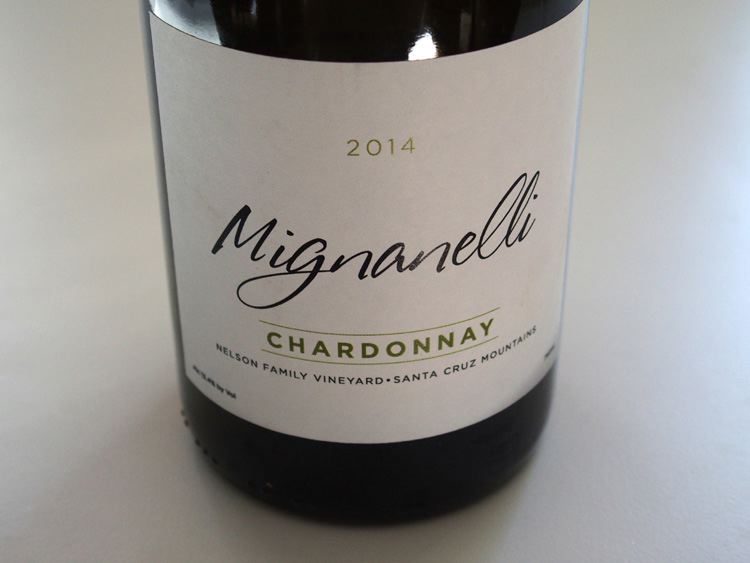 2014 Mignanelli Nelson Family Vineyard Santa Cruz Mountains Chardonnay 13.4% alc., $28. Vineyard planted in 1999 at 1,700 feet elevation in ancient marine sedimentary soil. Mt. Eden and Old Wente selections. Native fermentation, French oak barrel fermented (20% new), 100% malolactic fermentation. Mt. Eden and Old Wente selections. · Light lemon yellow color in the glass. Exuberant perfume of lemon cream, tropical fruits, buttery brioche, caramel and floral bouquet. Crisp, vivid and bright on the palate, with fruit flavors of lemon and pineapple and a hint of salinity. Harmonious, clean and fresh, with plenty of fruit goodness, and a vibrant disposition. Score: 92
2014 Peake Ranch Sierra Madre Vineyard Santa Maria Valley Chardonnay 14.3% alc., 327 cases, $40. · Moderately light golden yellow color in the glass. Shy perfume of citrus, tropical fruits, paraffin and oak. Slightly creamy on the palate with flavors of buttery oak, pineapple, yellow apple, guava and grilled lemon framed by integrated acidity. A solid wine that will find advocates, but not exceptional. Score: 89
Readers Take on 100-Point Scoring SystemIn the last issue of the PinotFile, I wrote an article about the decline of usefulness of the 100-point scoring system and provided a number of explanations. I asked readers to respond and here is a consensus of their illuminating comments.
Usefulness of 100-point system “I’m still not enamored with a point system of any kind and rely more on the sensory perceptions I glean from the descriptors”........”Put me down as frustrated by the scoring.”........”The usefulness of the 100-point scoring system will depend on the audience as serious Pinot Lovers will benefit from the descriptions of the wine, whereas the average person will look at a review and say that wine X must be better than wine Y because it is rated 95, not 91. I think it is useful to have both.”........”I agree with your assertion that the 100-point system is passé.”........”I agree with your premise that the 100-point scoring scale is almost useless. A high score for a wine only tells me that the taster liked it. The next question is who was the taster and how close does that taster’s palate match mine? So, based on the taster, I either buy the wine, ignore it, or do more research before I buy it.”........”Today, with the 100-point system, it’s all about where the wine gets at least a score of 90. This is critical as far as the wine’s pricing and desirability in the marketplace. Essentially the 100-point system has become a 6-point system, with most wines scoring between 89 and 95 and a rare wine receiving a score over 95. Essentially has become a joke.”........”Points do not have aroma, flavor or mouthfeel. Points can be useful IF you have reliable knowledge of the rater’s wine preferences. The question really is, ‘Will I like this wine?’ Points don’t answer that question, although they can be an indicator if you know the rather’s wine preferences.” Value of wine descriptions “I believe Parker was so successful, not because his palate is so much better, but he had a real way with words and if he liked a wine, you know it. If he loved a wine, you had to taste it. He was opinionated and you knew it. Agree or disagree, you knew what types of wine he liked and you could decide for yourself if that was the wine you wanted. Also, Parker’s 100-point scale was easy to understand, and it drove wineries to work even harder to succeed with their wines.”........”My main guide on what to buy are notes, not points. It doesn’t matter who you choose for tasting notes with a caveat. It does matter how well the taster describes the wine, and it does matter where the taster is consistent from wine to wine. With experience, the amateur wine geek can figure out which wines to buy based on the notes, as long as the notes aren’t too far afield from their own tastes.”........”I do read your descriptions closely looking for key phrases or words. Balance and good acidity are a must and fresh raspberry or cherry are also key words I look for.” More highly scored wines “I have noticed many more highly rated wines in the past few years than ever before and do not know if that is a change in palate, the wine quality, relaxation of the scoring system OR all above.”........”The 100-point system no doubt has its flaws. My biggest concern at present is score inflation. It used to be that 90 points as a great score, and still is in my book. However, over time, 90 as become ‘ordinary,’ and so the review needs to be a 92, 93, 94 and up to break through with retailers and consumers. As a result, you have a lot of wines out there that get extremely high scores that I just don’t think are that deserving.”........”The higher your scores are, the more retailers reference them, the more wineries reference them, and the more influential the review becomes. Hence the writer and publication gets more cachet.”........”Non-blind scoring increases the high scoring bias.”........The 100-point scoring system was OK when Parker began. As he evolved, grade inflation set it.” A standardized review format “I LOVE the format and have wished in the past what you described existed. To be able to compare specific attributes that I sense and taste to a professional’s would go a long way towards allowing me to better understand why I like the wines I like.”........”I totally like your suggested format although it would need to be thoroughly thought out. If all reviewers were to adapt to using the same format, it would be much easier for me to make an informed buying decision. I think you are on the right track!” On prime drinking years “One thing I think is important and helpful to me, and possibly many your readers is your guess-estimate on the prime drinking years of any particular wine.”........”The difficult angle is age ability. What is the expectation for serious development including bottle bouquet and secondary flavors? This has been difficult, and I’ve handled it by looking at pedigree, age of vines, commune, published tasting notes of older wines by trustworthy people before buying.” On wine costs and scores “If I’m spending over $40 a bottle, and I did just order some Maggy Hawk at $70, based solely on your recommendations, I don’t want a good wine, I don’t want a very good wine, I want a wine that is going to knock my socks off.”........”I taste a 95+ point wine and I expect it to be near life changing.”........”When I look at reviews now, I tend to quickly look for price and score. For Pinot Noir, if I see a 92/93 or higher score on a wine priced from $25 to $45, I would read it. For me to be interested in a wine priced above $45, it would need to have a score of 93 or higher. I am still looking for the great value bottles like a 90/91 score on a $20 or under wine.”........”My dilemma has always been the role that price plays in the rating.”
Summary Readers emphasized the importance of matching their palate with the reviewer regardless of whether they hone in on the description and or the score. As one reader noted, “Your scores and tasting notes seem to fit my palate or tastes, so I will continue to read, dream and buy (way too much) wine.” Price is also an important consideration for many as they search for the combination of high quality at a reasonable price. I might add here, that I do not look at prices before reviewing wines and try to keep this irrelevant in judging a wine. Most responders felt that their has been score inflation that has diminished the usefulness of the 100- point scoring system. The description of a wine seems of great importance, especially if the reader can see “between the lines,” and understands certain words or phrases that the writer uses that are a tip off indicating a special wine. The idea of a standardized review format used by all professional wine reviewers makes sense to many responders, but the enormity of creating an agreeable format, and instituting it among prominent wine writers who are notoriously protective of their individuality, makes it unlikely or even impossible. Finally, the demise of the 100-point scoring system in the foreseeable near term is improbable, even as Millennials are said to spurn the wine scores of experts. The reason is that scores are still remain the main driving force that sells wine. |